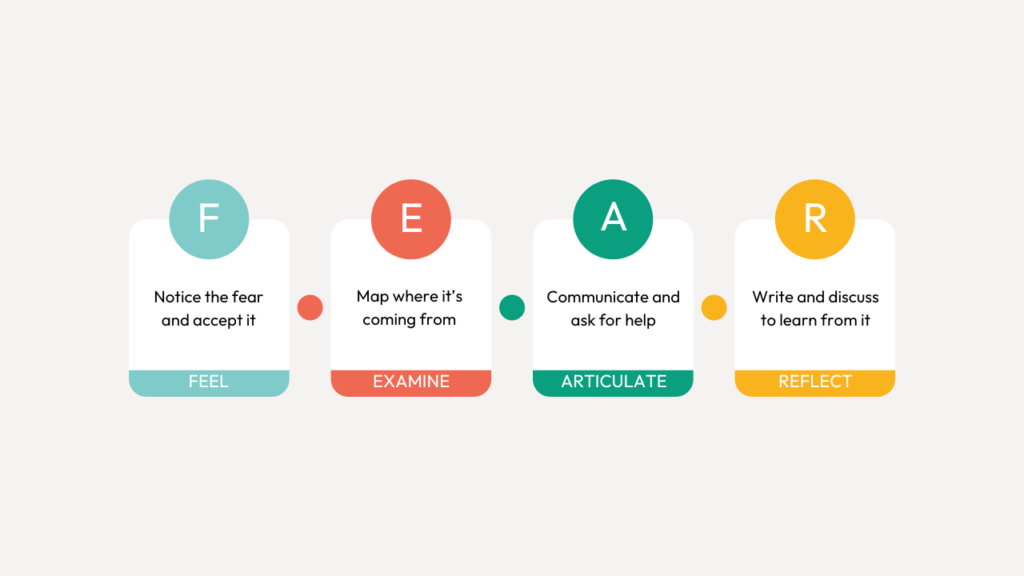Growing up, many of us are taught to fight off our fears—to be strong and confident, to cast away our doubts and insecurities. As adults, fear becomes something we feel we have to carry alone, afraid to share it because it might make us seem weak.
This is especially true for business leaders. Fear can be perceived as a lack of conviction. But the truth is, trying something new and pushing beyond the familiar is always going to be scary.
Launching a startup, developing a new product, or stepping into a new market means navigating the unknown. No matter how much we plan, there’s always uncertainty. And that uncertainty brings fear—whether it’s the fear of failing, being judged, or facing rejection.
Fear as a built-in Survival Guide
When you face something uncertain or threatening, your brain’s amygdala kicks into gear, triggering reactions that prepare you to either fight or flight. In addition to fast-acting neurotransmitters, your brain also uses neuropeptides, which act more slowly but help fine-tune your fear response, making sure you stay aware of potential risks.
While this response can feel uncomfortable—heart racing, sweaty palms, tense muscles—it’s actually designed to keep you safe. The heightened awareness helps you react quickly in the face of danger, but it can also be useful in non-life-threatening situations, such as navigating uncertainty in a business decision. In fact, moderate levels of arousal can boost performance by keeping you alert and focused.
Fear itself is not bad. It’s a natural response designed to protect you. In fact, as one of our oldest survival mechanisms, it can even be healthy. It can help avoid reckless decisions, heighten our awareness, and fuel our motivation.
Yet, we suppress it, leading to its worst effects—overthinking, poor communication, and missed opportunities because we shy away from risks. As a result, we often get all of its drawbacks without any of its benefits: work is slower because of analysis paralysis, communication is unproductive because we hold back information, innovation is scarce because we avoid taking any risks.
What if instead we embraced fear as a natural part of life, one that’s full of curiosity, experimentation, and creativity? Making friends with fear means recognizing that it’s not something to avoid or ignore, but rather something to treat as helpful information.
Using the F.E.A.R. Framework
Of course, that’s not an easy feat. We’re wired to blindly obey our fear instead of having a friendly conversation, and we haven’t been taught how to communicate our fears in a constructive way. Fortunately, there are simple steps you can practice to welcome your fear and even leverage it. I call it the F.E.A.R Framework:
1. Feel your fear. Your stress response to a perceived threat has an immediate physiological impact. Your heart beats faster, your breathing speeds up, your blood thickens, your skin produces more sweat. Rather than ignoring these signs, notice and accept them as a natural part of facing the unknown. A few deep breaths or simple stretches can help feel our fear without experiencing additional anxiety.
2. Examine the source of your fear. Once you’ve acknowledged your fear, take the time to understand where it’s coming from. Fear can stem from tight deadlines, financial pressures, or uncertainty about a project’s outcome. Using a metacognitive tool like mind mapping can help pinpoint the source of your fear. Engaging in this type of analysis can activate the prefrontal cortex, a higher-order part of your brain, which can then help you manage fear more effectively.
3. Articulate your needs. This step might be the hardest, as it requires radical vulnerability: sharing your fears with the people who matter and openly asking for help—whether that’s extra support on a project, coaching for public speaking, or mentorship to navigate a tricky situation. Sharing your fear doesn’t make you weak; it makes you agentic. And often, by simply voicing your concerns, you can find solutions that will help alleviate them.
4. Reflect on your experience. Finally, take the time to learn from the experience. Everyone is different, and so are our responses to fear and our coping mechanisms. How did acknowledging and sharing your fear impact the situation? What strategies worked best for managing it? How might you make friends with your fear quicker in the future? Journaling about your experience or discussing it with others can help you prepare for future challenges.
Making friends with our fears means exploring our inner world and opening up to others, being vulnerable in the face of distress, and building collective resilience by leading the way in sharing our concerns.
When you stop running from fear and start working with it, amazing things can happen. By feeling your fear, examining its source, articulating your needs, and reflecting on the experience, you can transform this natural response into a powerful driver of personal and professional progress.
As a leader, creating a space for these conversations fosters psychological safety, encouraging people to learn, reflect, and grow together through challenges. It’s not easy, but it’s worth the effort to build a safer, more courageous world—one where boldness is encouraged and vulnerability is celebrated.
This post is adapted from an article originally published in PRESENT MAGAZINE, VOL. 2. VULNERABILITY (2021).

